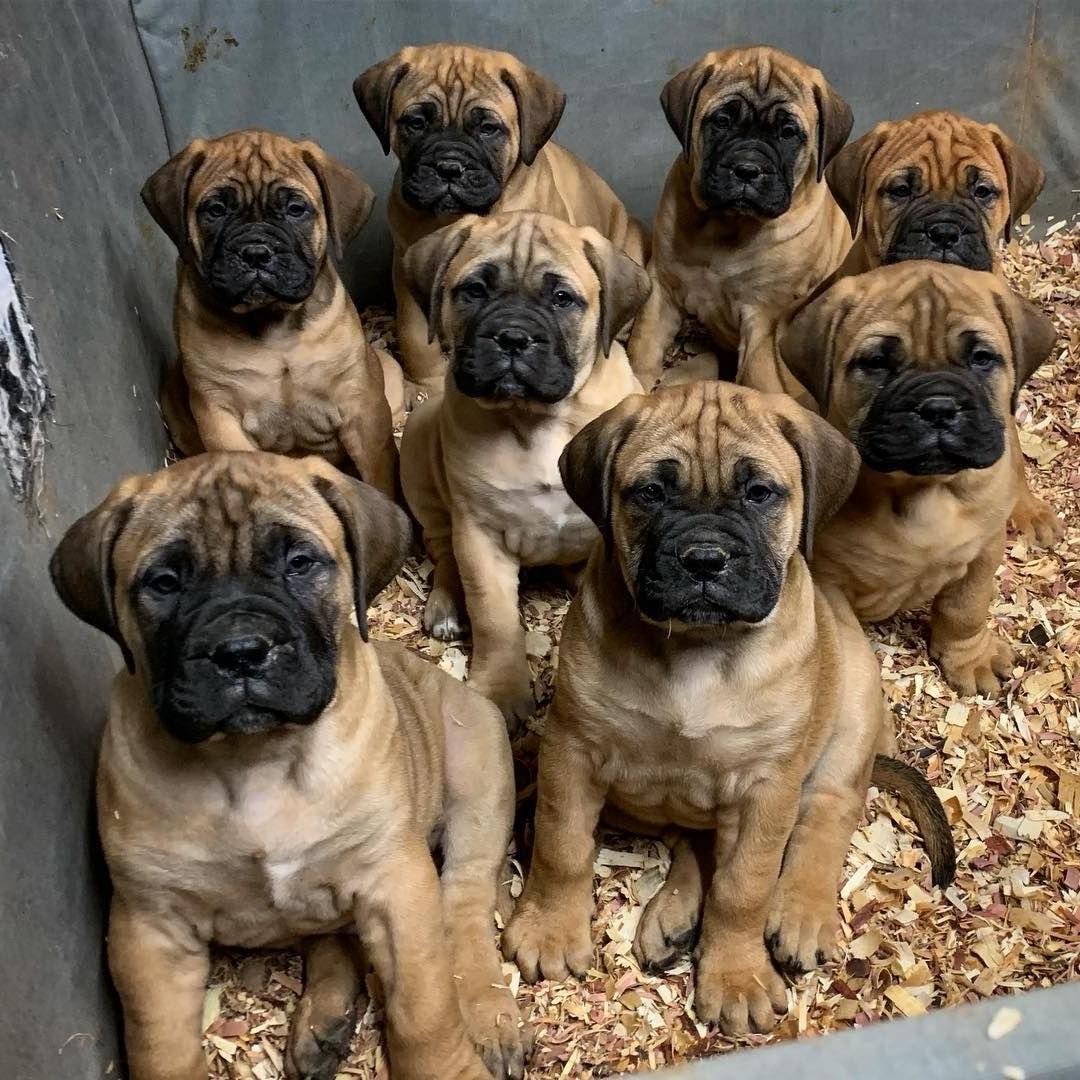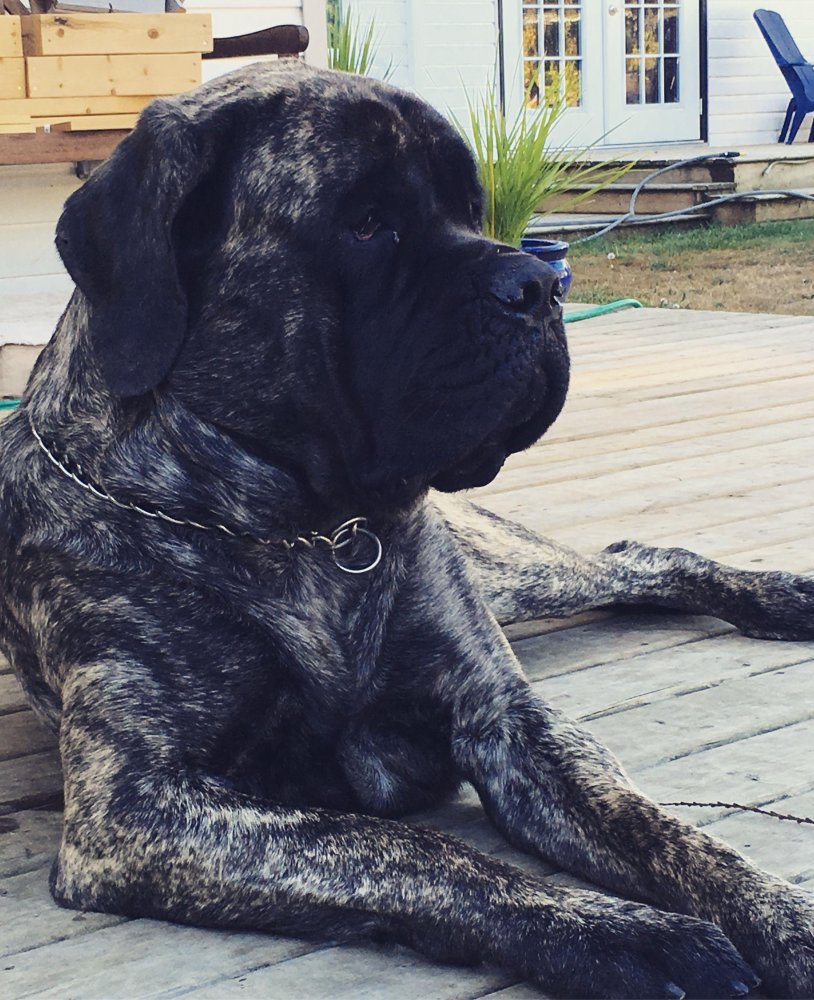- Breed Category: Working Group
- Country of Origin: England
- Average Height: Males 76 cm (30 in), Females 70 cm (27.5 in)
- Average Weight: Males 73-100 kg (160-220 lbs), Females 54-77 kg (120-170 lbs)
- Average Life Span: 6-10 years
- Grooming Requirements: Low, occasional brushing
- Exercise Requirements: Moderate, daily walks
- Coat Type: Short and dense
- Coat Color Variations: Fawn, apricot, brindle
- Shedding Level: Moderate
- Ear Type: V-shaped, pendant
- Tail Type: Straight, tapering
- Temperament: Gentle, protective, loyal
- Intelligence Level: Moderate
- Barking Tendency: Low
- Compatibility with Children: High, very good with kids
- Compatibility with Other Pets: Generally good with supervision
- Training Ease: Moderate, requires patience
- Common Health Issues: Hip dysplasia, bloat, heart issues
- Dietary Needs: High-quality, balanced diet
- Energy Level: Low to moderate
- Drooling Tendency: High
- Sensitivity to Weather: Sensitive to heat
- Overall Maintenance Level: Moderate
- Original Purpose: Guarding estates
- Year of Recognition by Kennel Clubs: 1885
- Apartment Friendly: Yes, with sufficient exercise
- Best Suited For: Families, experienced dog owners
- Cost of Ownership: High, due to size and health care
- Unique Traits: Massive size, gentle giant
- Popularity Rank: Moderately popular
Ever found yourself wondering if a dog can be both a gentle giant and a fierce protector? Enter the Mastiff. These impressive dogs are known for their massive size and loyal nature. Originating from ancient times, Mastiffs have a rich history as guardians and companions. Their imposing stature is matched by a heart full of devotion, making them a unique addition to any family.
This article aims to delve into the world of Mastiffs, exploring their distinct characteristics, storied past, and the care they require. Whether you’re considering bringing one into your home or simply curious about this majestic breed, understanding what makes a Mastiff tick is key to appreciating their role as both a friend and protector.
History and Origin of the Mastiff

Early Development of the Breed
The Mastiff’s roots trace back thousands of years, with evidence suggesting they were companions to ancient civilisations. These dogs were initially bred for their strength and size, making them ideal for various roles, from hunting to guarding. Over time, selective breeding honed their characteristics, resulting in the gentle giants we know today.
Role in Guarding and Companionship
Mastiffs have always been more than just pets. Their sheer size and protective instincts made them natural guardians, whether watching over livestock or standing sentinel at the gates of grand estates. Yet, beneath their formidable exterior lies a gentle soul, eager to form strong bonds with their human families. This dual role of protector and companion has cemented their place in many homes.
Key Historical Figures and Events
Throughout history, Mastiffs have been associated with notable figures and events. Julius Caesar reportedly admired their bravery in battle, while in more recent times, they have been cherished by royalty and commoners alike. These dogs have not only witnessed history but have also played a part in shaping it, standing by their humans through thick and thin.
Physical Characteristics of the Mastiff

Appearance
Mastiffs are truly a sight to behold. These dogs are massive, often weighing between 50 to 100 kilograms, with some even tipping the scales beyond that. Their size alone commands attention, but it’s their coat that adds to their majestic presence. Typically, Mastiffs sport a short, dense coat that comes in a variety of colours, including fawn, apricot, and brindle. Each coat is unique, often featuring distinctive markings that make every Mastiff one of a kind.
Unique Physical Traits
One of the most striking features of the Mastiff is their large, imposing stature. Their broad head and muscular build give them a powerful look, yet their eyes often convey a gentle, soulful expression. This combination of strength and softness is what makes them so special. Their droopy jowls and expressive faces are not just charming but also serve a purpose, helping them communicate a range of emotions to their human companions.
Temperament and Behaviour of the Mastiff

Typical Personality Traits
Mastiffs are known for their gentle and loyal nature. Despite their size, they are often described as gentle giants, displaying a calm and composed demeanour. Their loyalty is unmatched, and they form strong bonds with their families, always eager to please and protect. This protective instinct is a hallmark of the breed, making them vigilant guardians of their home and loved ones.
Suitability as a Family Pet and Guard Dog
When it comes to family life, Mastiffs are a fantastic choice. Their gentle nature makes them well-suited for homes with children, as they are patient and tolerant. As guard dogs, their imposing presence alone is often enough to deter intruders. They are naturally protective, but their calm temperament ensures they are not overly aggressive, striking a perfect balance between being a family pet and a guardian.
Interaction with Children and Other Animals
Mastiffs generally get along well with children, often displaying a nurturing side. They are protective yet gentle, making them ideal companions for kids. With other animals, Mastiffs can be quite sociable, especially if they are introduced to them early on. Their easy-going nature allows them to coexist peacefully with other pets, provided they are properly socialised.
Training and Exercise Needs for Mastiffs

Importance of Early Training and Socialisation
Getting a Mastiff off to a good start with early training and socialisation is crucial. These dogs are naturally protective, so introducing them to a variety of people, places, and other animals early on helps them grow into well-rounded adults. This early exposure ensures they are comfortable in different environments and situations, reducing the likelihood of unwanted behaviours.
Recommended Training Techniques
When it comes to training, positive reinforcement is the way to go. Mastiffs respond well to praise and treats, making them eager learners. Consistency is key, so regular training sessions that are short and engaging work best. Avoid harsh methods, as these can lead to fear or aggression. Instead, focus on building trust and a strong bond through patience and encouragement.
Daily Exercise Requirements and Activities They Enjoy
Mastiffs may not be as energetic as some breeds, but they still need daily exercise to stay healthy. A couple of short walks each day, combined with some playtime, usually does the trick. They enjoy activities that allow them to use their brains, like puzzle toys or basic obedience games. Remember, their joints can be sensitive, so avoid high-impact activities, especially when they’re young.
Health and Lifespan of the Mastiff

Common Health Issues
Mastiffs, like many large breeds, can face specific health challenges. Hip and elbow dysplasia are common due to their size, and they may also experience heart conditions like cardiomyopathy. Bloat, a serious stomach issue, is another concern. Regular vet check-ups are crucial to catch these issues early.
Average Lifespan and Health Tips
On average, Mastiffs live between 6 to 10 years. To help them reach the upper end of this range, a balanced diet and regular exercise are key. Keep their weight in check to reduce stress on their joints. Mental stimulation is just as important, so engage them with interactive toys and training sessions.
Preventative Care Recommendations
- Schedule regular veterinary visits for health screenings and vaccinations.
- Maintain a healthy diet tailored to their size and activity level.
- Provide joint supplements if recommended by your vet.
- Ensure they have a comfortable sleeping area to support their joints.
- Brush their teeth regularly to prevent dental issues.
Grooming and Maintenance for Mastiffs

Coat Care and Grooming Routines
Mastiffs have a short, dense coat that requires regular attention to keep it looking its best. A weekly brush with a rubber curry brush or a bristle brush helps remove loose hair and keeps their coat shiny. This routine not only maintains their appearance but also strengthens the bond between you and your Mastiff.
Shedding and Seasonal Grooming Tips
While Mastiffs are not heavy shedders, they do experience seasonal shedding, particularly in spring and autumn. During these times, increase brushing to a few times a week to manage the extra hair. A deshedding tool can be handy for tackling the undercoat. Regular baths, every couple of months, help keep their skin healthy and coat clean, but avoid over-bathing as it can strip natural oils.
Remember, grooming is more than just coat care. Regularly check their ears for signs of infection, trim their nails to prevent overgrowth, and brush their teeth to maintain oral health. These simple steps ensure your Mastiff stays comfortable and healthy year-round.
Diet and Nutrition for Mastiffs
Nutritional Needs for Optimal Health
Feeding a Mastiff isn’t just about filling a bowl. It’s about ensuring they get the right nutrients to support their massive frame and gentle nature. A balanced diet rich in high-quality proteins, healthy fats, and essential vitamins is crucial. Proteins help maintain muscle mass, while fats provide the energy they need for their daily activities.
Foods to Include and Avoid
Include lean meats like chicken and beef, along with fish for omega-3 fatty acids. Whole grains and vegetables are great for fibre and vitamins. Avoid foods high in fillers, artificial additives, and excessive fats, as these can lead to obesity and other health issues. Chocolate, onions, and grapes are definite no-nos, as they can be toxic to dogs.
Feeding Schedules and Portion Recommendations
Consistency is key when it comes to feeding schedules. Two meals a day, morning and evening, work well for most Mastiffs. Portion sizes depend on their age, weight, and activity level, so it’s best to consult with your vet for tailored advice. Remember, overfeeding can lead to obesity, which is a common issue in large breeds like Mastiffs.
Fun Facts and Trivia about Mastiffs

Interesting Tidbits about the Breed
Mastiffs are not just known for their size; they also hold a few records. The heaviest dog ever recorded was a Mastiff named Zorba, who weighed an astonishing 155 kilograms. Despite their massive size, Mastiffs are often referred to as “gentle giants” due to their calm and affectionate nature. They have a unique way of communicating with their humans, often using a combination of body language and vocalisations to express themselves.
Famous Mastiffs in Media or History
Mastiffs have made their mark in both history and pop culture. In ancient Rome, they were used as war dogs and were admired for their bravery. More recently, a Mastiff named Fang appeared in the Harry Potter series, capturing the hearts of fans worldwide. These dogs have also been featured in various films and TV shows, often portraying the role of a loyal and protective companion. Their presence in media highlights their enduring appeal and the special bond they share with humans.
Final Thoughts
Mastiffs embody the perfect blend of gentle companionship and steadfast protection. Their massive size and loyal nature make them both impressive guardians and loving family members. While they require specific care and attention, the rewards of having a Mastiff are immense, offering both security and affection. Embracing the unique traits and needs of this breed can lead to a fulfilling relationship that enriches both the dog’s and owner’s lives. Consider welcoming a Mastiff into your home to experience the joy and loyalty they bring.
